

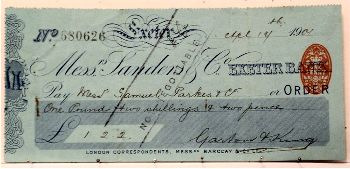
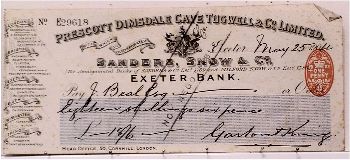
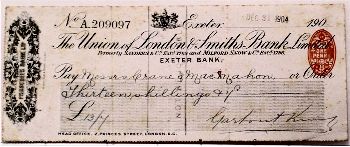
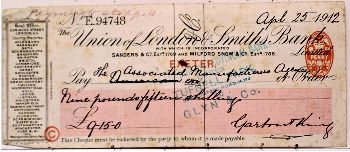 In the 21st Century the writing of and payment by Cheque for goods and services is much in decline but not so in the 19th and 20th Centuries.
In the 21st Century the writing of and payment by Cheque for goods and services is much in decline but not so in the 19th and 20th Centuries.
The four cheques illustrated survive in G & K’s archives and show the various guises and name changes the successors to The Exeter Bank and Sanders & Co went through just between 1901 and 1912. On the 1912 Cheque (bottom right) has been written ‘Payment Stopped’. It has been stamped with a National Provincial / Glyn’s Bank rubber stamp.
Garton & King and its predecessors had been customers of the Exeter Bank from its early days*. It was taken over by the Sanders family in 1810. Both the Sanders name and ‘Exeter Bank’ appear on the cheques in the first three images. Garton & King continued to be customers through the various acquisitions and mergers including the City Bank in 1901. The bank eventually became part of the National Provincial Bank in 1918.
*see also Year 1900 page.
The bank we know as NatWest was formed by the merger of the National Westminster Bank and the National Provincial Bank in 1970. It is believed that to this day the successors, Garton King Appliances, still bank with NatWest.
For those interested in monetary matters, and in particular those relating to Exeter Banking History, the images below may provoke interest. I am amazed these examples of ‘token’ coins have survived; they add to the monetary history of Exeter which includes the Exeter Mint set up in 1696 in the reign of William III and the £10 & £5 notes produced by Sanders & Co / Exeter Bank in the latter part of the 19th Century.
The reason that tokens were struck in the 18th century is because there was a dire shortage of small change. The copper coins of the time were very worn and new coinage was not being struck because the cost of the mint producing them often outweighed the value of the coin itself. However traders needed small change as workers needed to be paid in cash rather than goods. Traders and industrial people took it upon themselves to produce metal items that looked like coins and that would circulate locally and be accepted in payment for goods.
The Bishop Blaize tokens issued by Samuel Kingdon** were designed, engraved and manufactured in Birmingham by John C. Hancock. There are three varieties of the Halfpenny Token and two varieties of the Half Halfpenny (Farthing), the latter being specifically manufactured for collectors by the Birmingham die engraver John Westwood and dated 1791 or 1792. Whilst some 500,000 Halfpenny Tokens were struck, the Half Halfpenny (reverse shown below) is particularly rare. Examples of both tokens can be seen on display in the Royal Albert Memorial Museum, Exeter.
**see Golden Hammer Chapter 3.
‘Exeter Coinage’ (ISBN 0 906231 12 7) is a useful publication and includes information on the ‘Exeter Halfpenny’ Token.
From information provided by Jim Strawbridge of the Devon & Exeter Numismatic Society
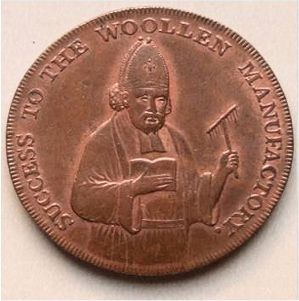 |
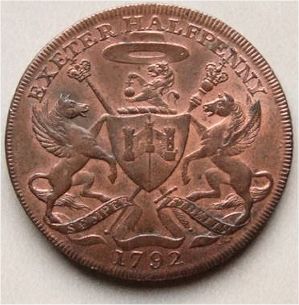 |
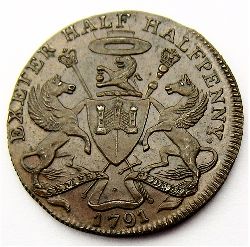 |
| The two sides of the Bishop Blaize Exeter Halfpenny Token Edge reads 'Payable at the warehouse of Samuel Kingdon', 29mm dia. |
Exeter Half Halfpenny (reverse - obverse is similar), 24mm dia. |
|
June 2021
Top of the page
See also:
1900 - A Year Under Scrutiny
The Stationery Cupboard — Golden Hammer Chapter 3
Sitemap / Contents